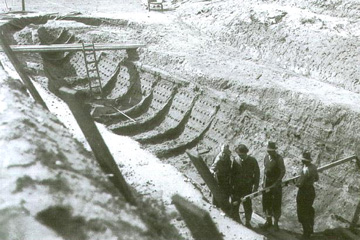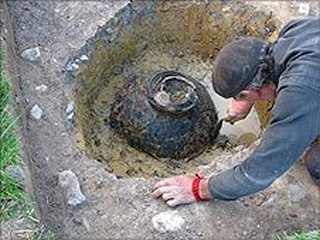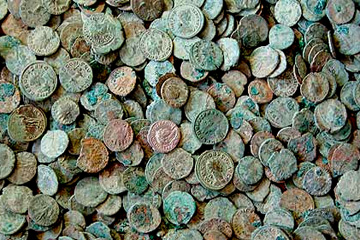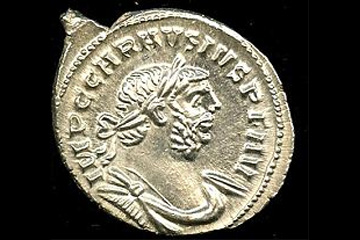A Righteous Detectorist
We don't usually report the activities of metal detectorists - vile spawn of Satan that they are - but we are making an exception to praise one of these creatures who has behaved in an entirely laudable and praiseworthy manner.
First a word about why we are so opposed to what many regard as a harmless hobby. After all, if old Harold is out waving his metal detecting machine over an empty field, he can't be roaming the streets robbing little old ladies and vandalising phone boxes and bus shelters. The problem is that more often not he is vandalising something far more valuable than a tatty phone box and robbing posterity of more than its purse: he is vandalising history and robbing all of us of irreplaceable knowledge.
Invented originally to detect mines, the metal detector's potential was quickly realised by people who had an interest in finding buried objects. Even today, a metal detectorist can make a useful amount of beer money by sweeping his instrument along a beach as evening draws on and retrieving the coins dropped out of people's pockets as they change into swimwear. Detectorists thus become used to hearing a beep in their headphones and immediately digging in with the trowel they carry to unearth the metal that has triggered the machine.
When it comes to beaches and lost coins or keys, no one can take exception to the activities of these people. Some folk collect stamps, others the numbers on train engines, and yet others spend hours waving a metal detector back and forth. It takes all sorts to make a world.
Alas, it soon occured to some unscrupulous person that if sweeping a beach might be profitable, sweeping the site of an ancient city might be even more so. Naturally, as soon as he heard the beep in his headphones, his Pavlovian response took over and he unearthed the source of the beep. At first he found objects an inch or two below the surface, but as the machines have become ever more powerful and sensitive, detectorists are digging deeper and deeper, a foot or more into the earth.
Now let us compare the methods of the archaeologist and the metal detectorist.
The archaeologist carefully surveys and lays out a grid. Then he methodically clears the area inside that grid, noting and recording the pottery he finds, the varying colours of the earth he digs up, and so on. If, as he sweeps the earth, he encounters anything out of the ordinary, he lays aside his stiff brush and resorts to a camel's hair brush and the sorts of tools a dentist uses to probe inside your mouth. If, by good fortune, he discovers a bit of metal, he will have records of where it was found, what objects (if any) were found with it, the date of the pottery in the same level, whether the metal was wrapped in cloth, hammered into a plank or buried in a pot.

|
| Archaeologists standing inside the buried Sutton Hoo longship. The ribs and nails that you see are nothing more than discoloured sand. |
To get an idea of what that means, look at the picture opposite of the Sutton Hoo Saxon ship. The dots are the rusted remains of iron nails; the timbers of the ship had completely rotted away and what appears to be ribs and planks are, in fact, nothing more than delicately excavated stains in the sandy soil! Yet thanks to the light touch of skilled archaeologists, we have been able to recreate not only the ships, but also the scene in the single mid-ships cabin where the dead king was laid, each weapon, pot and candlestick in its correct location.
Indeed, most of the metal objects were found in pieces, broken by the weight of earth pressing down on them. Because they were found together and recorded in detail, however, the conservators have been able to reassemble the pieces to make up cauldrons, weapons and the famous and fabulous masked helmet.
Now consider the metal detector: he hears a beep, he digs straight down to whatever it was and uproots it from the soil. There is no record kept, no careful noting of context, nothing but a hole in the ground.
Imagine if such a flat-skulled vandal had stumbled across the site of Sutton Hoo! What would we have today? A pile of rusty nails and a jumble of bronze fragments, with no way of saying what they were or why they were discarded, and only guesswork to say whether one piece fits with another. The amazing ship would never have been found, for by the time the archaeologists got to the site there would be nothing left except holes of varying sizes in the ground.
That is why I am taking the time to honour Dave Crisp, a metal detectorist from Devizes in Wiltshire, who was exercising his nefarious hobby in a field not far from Frome in nearby Somerset. His machine beeped and he unshipped his trowl and started to dig. From the sound his infernal machine had made, he guessed that he was onto something big, a thought which encouraged him to keep digging.
At just over a foot below the surface he finally struck what he was looking for, a fingernail-sized circle of metal encrusted with clay. Dave carefully broke away the lump of clay and stared at what he had found - and now comes the first thing for which we commend him: he recognised it!
"I put my hand in, pulled out a bit of clay and there was a little Radial, a little bronze Roman coin. Very, very small, about the size of my fingernail," he said in a radio interview.
To be honest, I hope that I would recognise a Roman coin when I see one, but to be able to give it a name is beyond me. Dave, however, knew his subject and although he had never found such coins before, he had researched what he might find and had the knowledge to recognise and appreciate the object.
Before leaving the spot, Dave waved his detector over the hole and found that it still beeped. He put his hand into the ground again and felt around. To his delight he found another coin - and then another and another. With half a dozen mud-encrusted coins in the palm of his hand, it gradually dawned on him that he had made a remarkable discovery - and now comes the second thing for which we commend him. He filled in the hole and walked away.
There is probably a generation of metal detectorists turning in their graves at those words. To walk away and leave something in the ground, where another metal detectorist might find it or the goblins hide it (or whatever it is that detectorists fear) goes against the darkest traditions of the occupation. Nevertheless, that is exactly what Dave did.
In the morning he went straight to the authorities at the local museum and reported what he had found. One glance at the coins in his hands and the curator cancelled all engagements, hung the "Closed" sign in the museum window, and ran for his car. (Actually, I'm being a bit dramatic there. It all took time to organise and the phone lines ran hot for an hour or two before a suitable team had been assembled to head for the field where Dave had been "detectoring".)
Anna Booth, Finds Liason Officer for the museum is unstinting in her praise for Dave. "Because Mr Crisp resisted the temptation to dig up the coins, it has allowed archaeologists from Somerset County Council to carefully excavate the pot and its contents."

|
| An archaeologist works to clear the clay pot discovered by Dave Crisp. |
They carefully surveyed a square and then began to dig. It took nearly a day to get down to the level of the coins, but their care was rewarded, for they found that the coins were in a large pottery jar about 18" in diameter. Unfortunately the neck of the jar was extremely narrow and the coins inside were so welded together by mud and corrosion that it was impossible to remove them through the neck. The archaeologists had to break the top off the jar and then lift masses of coins out.
Over the next three days and watched eagerly by Dave and members of his family (as well as members of the public attracted by all this activity in a field), the archaeologists removed every coin and all the fragments of the jar and took them all back to the museum. There the first priority was to keep the clay damp, as otherwise the mud and corrosion would have hardened and made it impossible to separate the coins. Washing and cleaning the coins took three whole months!

|
| Some of the 52,503 coins discovered in a clay jar by Dave Crisp. |
Yes, three whole months, because when the work was finally done and the coins lay in neat rows on the archaeologists' desk, there were 52,503 of them, all apparently minted in the forty years between AD 253 and AD 293. The total weight of metal was 350lbs! So far 44,245 of them have been identified, the rest are awaiting cleaning and conservation which may enable us to read the inscriptions on them.
What is really exciting the archaeologists, however, is that 766 of the coins were minted under the reign of the usurper Carausius, who reigned as emperor in Britain for seven years until he was assassinated by his finance minister - presumably the man who had minted these very coins! Five of the coins are solid silver, a reminder that Carausius, in an attempt to legitimise his rule, minted the first silver coins seen in the Roman empire for generations.

|
| A silver coin minted by the usurper Carausius. |
Debate has long raged about exactly how powerful Carausis was. His name on a Roman milestone found near Carlisle indicates that the whole of Roman Britian was in his power, but the discovery of so many of his coins means that we will be able to trace the development of his mint - and therefore of his power - in unprecedented detail.
Roger Bland, Head of Portable Antiquities and Treasure at the British Museum, is as excited as anyone else at this discovery. "This find presents us with an opportunity to put Carausius on the map. School children across the country have been studying Roman Britain for decades, but are never taught about Carausius - our lost British emperor."
Invented originally The actual inventor was, I believe, a Polish refugee from Hitler's invasion of his homeland during World War II. The Polish contribution to the Allied victory has been somewhat underplayed, but in fact it was Polish mathematicians who first cracked the famous Eniga code, and Lieutenant Jozef Stanislaw Kosacki created the first portable mine detector. It was a somewhat Heath Robinson affair and required a separate battery to power it, but it proved its worth in the Battle of Alamein and was subsequently used in the invasions of Sicily and Normandy. The sale of surplus equipment after the war led to the rise in the hobby of metal detecting. Return
first silver coins Lacking the sophisticated banking system that does so much to promote stability and prosperity in our modern world (for the benefit of American readers, the foregoing is a sample of irony) the Roman government had to resort to diluting the metal of the coins in order to make ends meet. (It's so much easier just to print more paper.) The result was that by this time supposedly silver coins were largely base metals such as lead and tin, so the solid silver coins of Carausius were a sensation and were much in demand. Return
© Kendall K. Down 2010





